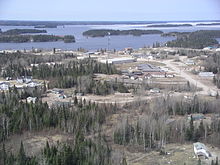Garden Hill First Nation



Garden Hill is the largest and most populated of 7 reserves of the Garden Hill First Nations. The First Nation community is located in the northeast section of the Canadian province of Manitoba on the shore of Island Lake. Garden Hill had a population of 2,776 in the Canada Census of 2011.[1] The residents of Garden Hill speak Oji-Cree, the traditional First Nations language, and English.
It is only accessible by winter ice roads via St. Theresa Point and by air. Nearby on Island Lake are the communities of Wasagamack of the Wasagamack First Nation, St. Theresa Point of the St. Theresa Point First Nation and the northern settlement of Island Lake.
History
In the early 1900s, there were no chiefs, but there were leaders called "headmen". They earned their status by establishing a reputation for generosity, service, wisdom, spirituality, courage, diplomacy, dignity, loyalty and personal magnetism. These leaders achieved status by influence, not by possession of wealth, but by the distribution of it. The shared generosity because of beliefs, values, traditions, and customs required by this behaviour. The chief with the longest time in the position was Henry Fiddler, who held the position of Chief for 22 years from 1931-1953.
Garden Hill First Nations was part of the bigger Island Lake First Nation. In 1969, Island Lake First Nation separated into four: Garden Hill First Nations, Red Sucker Lake First Nation, Wasagamack First Nation, and St.Theresa Point First Nation.[2]
Demographics
The population of Garden Hill was 2,776 in the Canada Census of 2011 an increase of 46.3% from 2006. In 2006 there were 1,898 residents. There were a total of 595 private dwellings. The population density was 33.7 per square kilometres on a land area of 82.48 square kilometres. The median age was 18.9.[1]
Garden Hill First Nations
Garden Hill First Nations is a signatory of Treaty 5. As of February 2015 Garden Hill First Nations had a registered population of 4,567 with 3918 members living on reserve and 649 members living off reserve.[3] Members elect a chief, vice chief and seven councillors through a Custom Electoral System.[3]
Territory
The 7 reserves of the Garden Hill First Nations include:[3]
- Amik Wachink Sakahikan is 1,339.5 hectares (3,310 acres) 54°15′04″N 94°58′11″W / 54.2511°N 94.9696°W on Beaver Hill Lake.[4]
- Bella Lake Exchange Lands is 174.80 hectares (431.9 acres) 53°53′03″N 94°33′10″W / 53.8842°N 94.5528°W.[5]
- Garden Hill First Nation is 7,357.30 hectares (18,180.3 acres) 53°52′17″N 94°38′27″W / 53.8714°N 94.6408°W.[6]
- Pe-Ta-Waygamak is 6,092.30 hectares (15,054.4 acres) 53°39′38″N 94°25′42″W / 53.6606°N 94.4283°W on the south shore of Island Lake.[7]
- Seeseep Sakahikan is 1,361.80 hectares (3,365.1 acres) 53°56′14″N 94°57′56″W / 53.9371°N 94.9655°W northeast of Island Lake.[8]
- Wesha Kijay Wasagamach is 203.50 hectares (502.9 acres) 54°22′39″N 95°00′08″W / 54.3776°N 95.0022°W on the northwest shore of Wasakamak Bay on Beaver Hill Lake.[9]
- Wolf River is 1,575.10 hectares (3,892.2 acres) 53°52′04″N 93°58′52″W / 53.8678°N 93.9811°W on the eastern end of Island Lake.[10]
Education
There are two schools in Garden Hill. The elementary school is named Kistiganwacheeng Elementary School and the secondary school is called Garden Hill First Nation High School. Garden Hill Student Services office is located in Winnipeg, the office handles post-secondary students that attend various institutions.
Gallery
 |
 |
References
- ^ a b "Canada Census 2011". Retrieved 2014-01-14.
- ^ "Garden Hill First Nation" (PDF). Retrieved 2015-03-15.
- ^ a b c "AANDC (Registered Population)". Retrieved 2015-01-14.
- ^ "Natural Resources Canada-Canadian Geographical Names (Amik Wachink Sakahikan)". Retrieved 2015-03-15.
- ^ "Natural Resources Canada-Canadian Geographical Names (Bella Lake Exchange Lands)". Retrieved 2015-03-15.
- ^ "Natural Resources Canada-Canadian Geographical Names (Garden Hill First Nation)". Retrieved 2015-03-15.
- ^ "Natural Resources Canada-Canadian Geographical Names (Pe-Ta-Waygamak)". Retrieved 2015-03-15.
- ^ "Natural Resources Canada-Canadian Geographical Names (Seeseep Sakahikan)". Retrieved 2015-03-15.
- ^ "Natural Resources Canada-Canadian Geographical Names (Wesha Kijay Wasagamach)". Retrieved 2015-03-15.
- ^ "Natural Resources Canada-Canadian Geographical Names (Wolf River)". Retrieved 2015-03-15.

